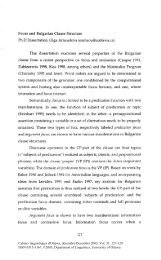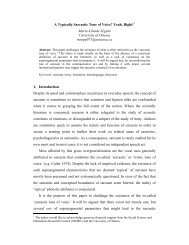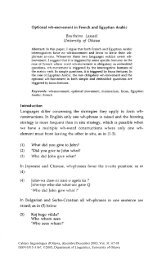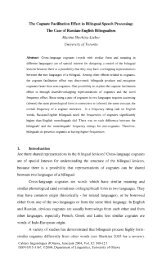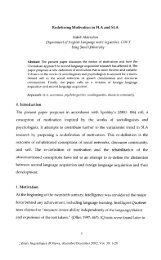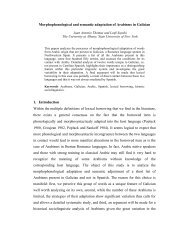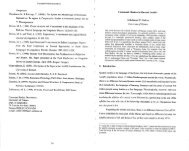Interlingual and Intralingual Interference during Gender Production
Interlingual and Intralingual Interference during Gender Production
Interlingual and Intralingual Interference during Gender Production
Create successful ePaper yourself
Turn your PDF publications into a flip-book with our unique Google optimized e-Paper software.
Denisa Bordag<br />
average) <strong>and</strong> had been learning Czech for 4.6 years on average. The Czech<br />
participants tested in the German experiment (German was the second language)<br />
started to learn German after their 8th year (at 14 on average) <strong>and</strong> had been<br />
learning German for 8.4 years on average. Many of them experienced long<br />
periods when they were not using German at all, so although they had been<br />
learning German almost twice as long as the German subjects, their proficiency<br />
in the foreign language was on average not exceedingly higher than that of the<br />
German subjects. The proficiency of the subjects was judged on the basis of an<br />
informal interview in subjects" second language at the beginning of the<br />
experiment, the information they provided in the questionnaire <strong>and</strong> their rating of<br />
their familiarity with the experimental items. Most German subjects have already<br />
passed or were just about to take the German equivalent of the English B.A.<br />
exams in Czech Studies (Zwischenpriifung). All Czech participant had sufficient<br />
knowledge of German to study at this language at the University of Leipzig.<br />
Highly advanced subjects or subjects below the level of intermediate were not<br />
tested or not included in the analysis. All subjects were paid for their<br />
participation.<br />
2.1.3 Materials<br />
The target stimuli were 72 line drawings in the Czech <strong>and</strong> 70 in the German<br />
experiment. Pictures of forty-four nouns were chosen as experimental items,<br />
none of them were cognates. The experimental items were partly different for<br />
each experiment to match all conditions (see below). The gender of half of the<br />
nouns was congruent with that of their translation equivalents (e.g. strom <strong>and</strong><br />
Baum, both rnasculines), the gender of the other half differed from that of their<br />
translation equivalents (e.g. obraz (masculine) <strong>and</strong> BUd (neuter». They were all<br />
easily-depictable concrete nouns with high frequency both in Czech <strong>and</strong> in<br />
German. The majority of the experimental items were monomorphemic <strong>and</strong><br />
inanimate. Each set of 22 nouns consisted of 8 masculines, 8 feminines <strong>and</strong> 6<br />
neuters. Their length ranged between one <strong>and</strong> three syllables <strong>and</strong> each set<br />
contained the same number of mono-, di- <strong>and</strong> trisyllabic masculine, feminine <strong>and</strong><br />
8



